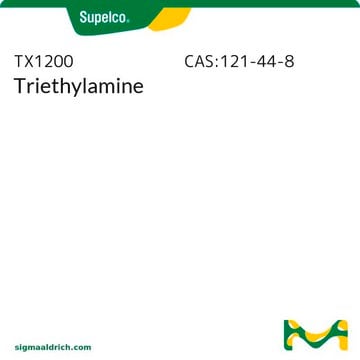90337
Trietilamina
for amino acid analysis, ≥99.5% (GC)
Sinônimo(s):
N,N-Dietiletanamina
About This Item
Produtos recomendados
grau
for amino acid analysis
densidade de vapor
3.5 (vs air)
pressão de vapor
51.75 mmHg ( 20 °C)
Ensaio
≥99.5% (GC)
forma
liquid
temperatura de autoignição
593 °F
prazo de validade
42 mo.
Lim. expl.
8 %
Impurezas
≤0.1% water
índice de refração
n20/D 1.401 (lit.)
pH
12.7 (15 °C, 100 g/L)
pb
88.8 °C (lit.)
pf
−115 °C (lit.)
densidade
0.726 g/mL at 25 °C (lit.)
cadeia de caracteres SMILES
CCN(CC)CC
InChI
1S/C6H15N/c1-4-7(5-2)6-3/h4-6H2,1-3H3
chave InChI
ZMANZCXQSJIPKH-UHFFFAOYSA-N
Procurando produtos similares? Visita Guia de comparação de produtos
Aplicação
- Surface-grafted macromolecular nanowires with pedant fluorescein chromophores by dense non-aggregated nanoarchitectonics as versatile photoactive platforms.: This research demonstrates the use of triethylamine in the synthesis of surface-grafted macromolecular nanowires with fluorescein chromophores, presenting their applications as versatile photoactive platforms in biochemistry and materials science (Kuciel et al., 2024).
Palavra indicadora
Danger
Frases de perigo
Declarações de precaução
Classificações de perigo
Acute Tox. 3 Dermal - Acute Tox. 3 Inhalation - Acute Tox. 4 Oral - Eye Dam. 1 - Flam. Liq. 2 - Skin Corr. 1A - STOT SE 3
Órgãos-alvo
Respiratory system
Código de classe de armazenamento
3 - Flammable liquids
Classe de risco de água (WGK)
WGK 1
Ponto de fulgor (°F)
12.2 °F - closed cup
Ponto de fulgor (°C)
-11 °C - closed cup
Equipamento de proteção individual
Faceshields, Gloves, Goggles, type ABEK (EN14387) respirator filter
Certificados de análise (COA)
Busque Certificados de análise (COA) digitando o Número do Lote do produto. Os números de lote e remessa podem ser encontrados no rótulo de um produto após a palavra “Lot” ou “Batch”.
Já possui este produto?
Encontre a documentação dos produtos que você adquiriu recentemente na biblioteca de documentos.
Os clientes também visualizaram
Nossa equipe de cientistas tem experiência em todas as áreas de pesquisa, incluindo Life Sciences, ciência de materiais, síntese química, cromatografia, química analítica e muitas outras.
Entre em contato com a assistência técnica







